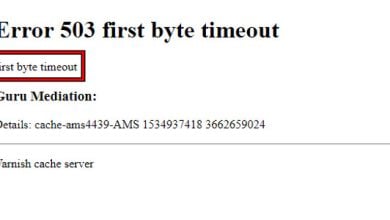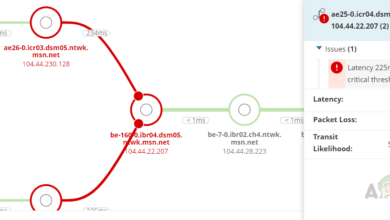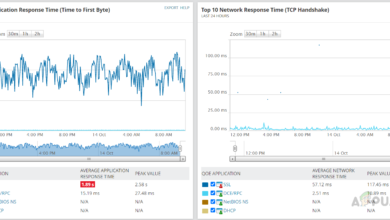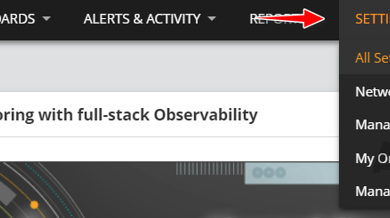Dameware Remote Support Review – A Software Created for System Admins and MSPs
The work of a System Administrator or IT technician in any business usually revolves around the installation, monitoring, maintenance, and also provision of support for the various computer systems. It’s not the easiest of tasks but the development of various dedicated software has seen a significant reduction in the workload through automation. The Dameware Remote Support by SolarWinds is one such tool that will be really convenient for the system admin. It is a software that will allow you to remotely access all the servers and PCs both inside and outside your network.
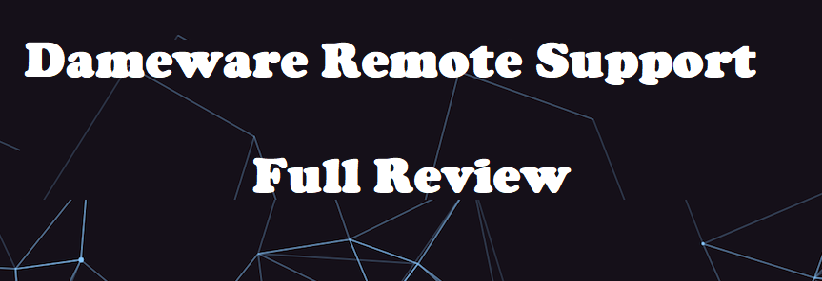
If you have tried guiding a non-tech person through the process of resolving an issue on their computer through the phone then you will appreciate the need for this tool. Or if you have had to come back to the office because a server went down after you had clocked out. Also, in many setups today, it is common to have the various IT components distributed in different locations. Therefore, having a remote desktop will save you from having to take numerous trips which then translate to less time taken to resolve various issues.
What makes the Dameware Remote Support software so great is that on top of the remote access capabilities, it is integrated with a number of system management tools that make it easy for you to quickly identify the root cause of a problem. I also like that SolarWinds based their User Interface on the Microsoft Management console which many people are already familiar with from their interaction with the Windows Operating System.
The Dameware Remote Support is implemented wholly within the premise of your organization which puts you in control of every aspect of its management.
Follow along as we break down every aspect of this remote desktop software starting from its deployment all the way to its capabilities, pricing, and disadvantages of using it. And at the end of it all, we will tell you why it is perfect for you. That is assuming that it’s not already clear to you by then.
Dameware Remote Support Installation
The installation process of this software will depend on the deployment model that you choose. This can either be the Stand-alone mode or the Centralized server mode. What’s the difference?
Standalone Mode
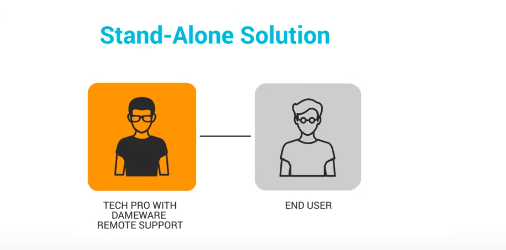
This is a deployment method where you install the software on every single machine that you will be using it on. You will still have access to all the features of the Dameware Remote Support but the licenses are managed individually on each computer. The good news is that you don’t have to worry about the installation of the Dameware client agent that is installed on the remote computer to enable the remote connection. Dameware provides you with numerous ways you can deploy the agent directly from the admin computer such as installation on demand, the use of EXE installers, or installation using MSI and MST installers.
When Would I Recommend Using the Stand-alone Mode
- When you do not have a significant number of remote computers to control.
- If all the end-users are located inside your network. The standalone mode cannot communicate outside your firewall.
- When you have a small and decentralized IT department.
To install the Standalone Mode simply run the installation file and follow the installation wizard. Then when prompted select the Standalone Install.
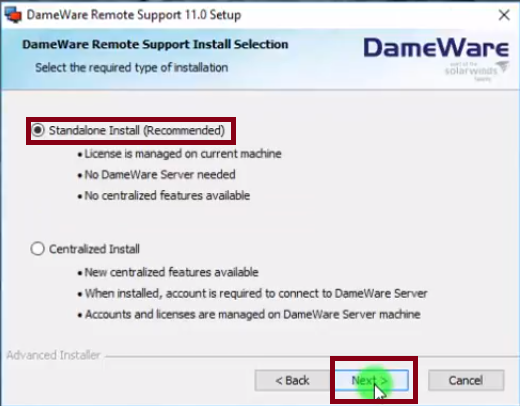
Centralized Mode
This is the higher end form of deployment and comes with its benefits over the standalone installation. For starters, the central server includes the administration console which allows you to manage all the licenses and users of the software from a single interface. That is including the assignment of permission rights to the users which is all made easier by the ability to integrate Dameware with the Active Directory. From the administrative console, you can also create a global host list that will be accessible to all the Dameware users and also track the list of all the open internet sessions.
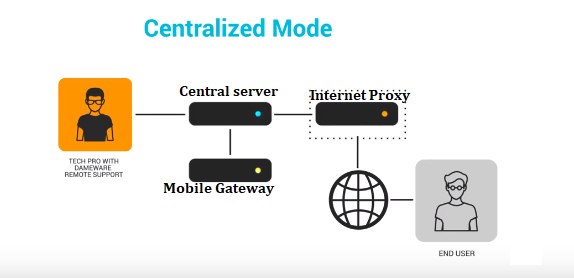
Additional Benefits of the Centralized Server over the Standalone mode
The biggest advantage of the Dameware centralized mode over the Standalone mode is the two additional server components that come bundled with it. These are the Dameware Internet proxy which facilitates remote connections with users that are outside your internal network. And the Dameware Mobile Gateway that allows technicians to use their Android and iOS devices to remotely control the host computers.
How to Implement the Centralized Server in your Organization
If you are a small business and you are not worried about exposing your internal network to the internet then you can install all the three components on a single server or what we call the express install. Once you launch the Dameware server installation file, follow the installation Wizard and you will come across the Express Dameware Central Server Install option.
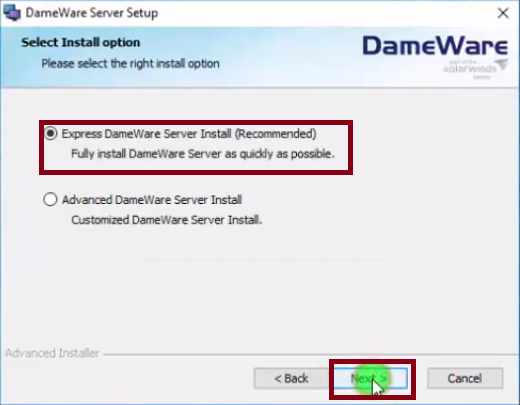
Otherwise, we recommend using at least two servers. This way you install the Dameware server and the Mobile Gateway on one machine and then set up the second server as a DMZ where you can install the Internet proxy component. Although for maximum security as required by big enterprises and government agencies, you will have to install each of the components on its own server.
So, now when installing Dameware on different servers you will select the Advanced Dameware Central Server Install instead of the Express option. Next, select the component that you want to be installed on that specific server and then you can proceed with the installation process.
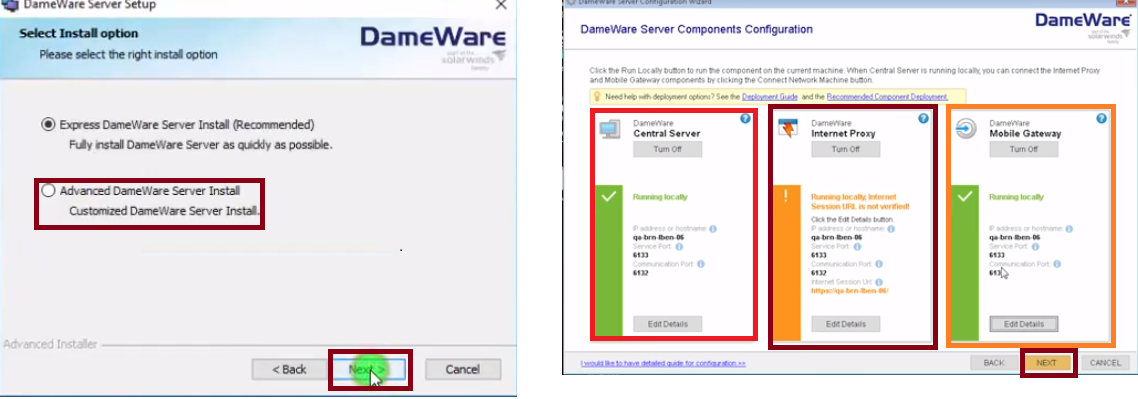
Oh and make sure to check whether the executable file has been blocked before you can begin the Dameware installation. To do this, right-click on the file and go to properties. If it is blocked you will be presented with an unblock button.
Also, if you are deploying Dameware in Centralized mode you should have some basic port forwarding skills so that you are able to open the necessary ports on your router and computer firewall. Or you could follow our guide on How to Configure Dameware ports.
Configuring Dameware on the Client Computer
Once you have set up all the components on the specific servers, you will still have to install the Dameware client on your computer so that you can be able to send the connection requests to remote computers. The process is pretty straightforward. Just run the Dameware Remote Support installation file and now instead of choosing Standalone, select the Centralized Install option. You can refer to this guide for more information.
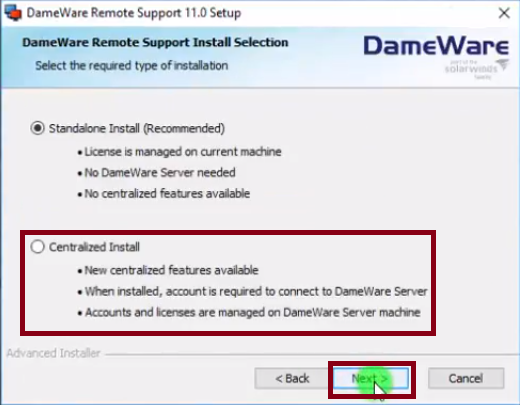
Also, just as we did with the standalone mode you will also need to install the Dameware client agents on the remote computer to allow it to receive connection requests. Again, you can complete all this right from the remote computer using any of the methods highlighted here.
When Would I recommend the Dameware Centralized Mode
- When your business has a significant number of remote computers to control.
- There is the need to support end-users that are outside your internal network.
- If you want to be able to use your mobile device to provide remote support to end-users.
Dameware Remote Support Features Overview
So, now that we are done with the installation, I think the next step is to highlight the full capabilities of the Dameware Remote Support. And to do this we will split this section into two parts. First, we will look at the Dameware Mini Remote Control which is the core component of the Dameware Remote Support and then we will look at the additional administration tools which allow you the extra capabilities such as integration with the Active Directory.
The Dameware Mini Remote Control(DMRC)
This is the tool in SolarWinds Dameware Remote Support that enables you to connect to remote Windows, Linux, and Mac computers. It can be used to establish 5 types of connections.
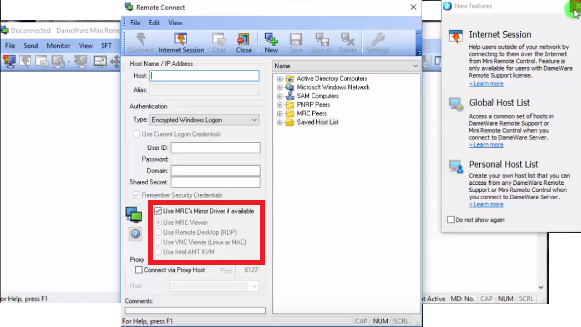
MRC Viewer connection
This is the type of connection that is established between the Dameware Mini Remote Control and Windows computer.
VNC Connection
This is the connection type used to link the DMRC to Mac and Linux systems. Just select the device you want to remotely access from the DMRC interface check the VNC viewer option and proceed to connect. Mac computers do not natively accept remote connections from Windows computers and you will thus have to manually configure them. This is a detailed guide on how to remotely control Mac computers using Dameware.
Internet Connection
This is the connection type established between the DMRC and remote computers that are outside your internal network. To initiate this type of connection look for the internet session icon on the Mini Remote Control’s taskbar.
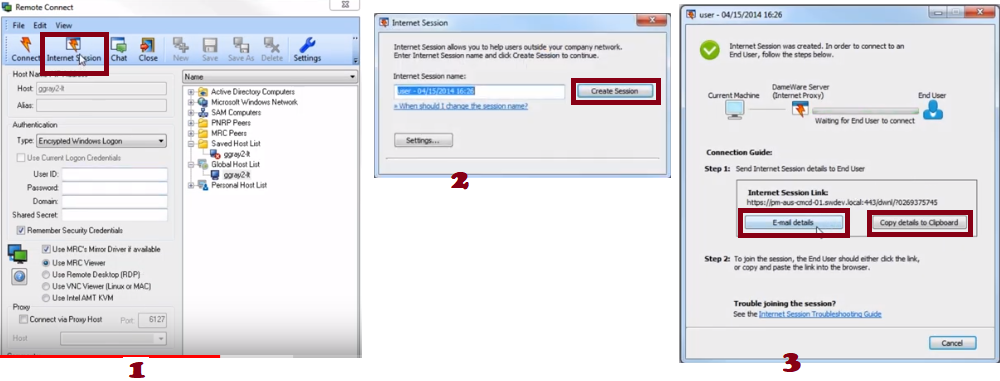
When you click on it, a setup wizard will appear and you just have to follow it to create the internet session. At the end of the setup process, you will be provided with a link that you are supposed to send to the remote desktop. If you have an email client the DMRC provides you with a direct way to email the link to the end-user. Otherwise, you will have to copy it to the clipboard and then send it via another medium. When the end-user receives the link they need to click on it and once they accept the connection you can begin controlling them remotely.
Intel vPro KVM Connection
This is the connection type between the DMRC and out of band computers. It allows you to connect to devices that are powered off, those in sleep or hibernation mode, or crashed computers. This will be particularly useful in those instances when you want to access the bios or boot menu of host computers.
Standard RDP connection
This provides the basic remote access functionality similar to the native Windows Remote Desktop. The advantage of launching this connection via the centralized DMRC interface is that you will have access to your global host list which facilitates faster connection.
Once you have established a connection with the remote computer then you can use the Dameware Mini Remote Control to perform troubleshooting and problem resolution tasks. The tool also allows you a number of functionalities that I will highlight briefly.
File Sharing – You can easily send files between the client and host computers through a simple drag and drop. This will be great for when you need to install certain software or apply patches to the remote computer.
Real-time chat – The DMRC allows the client computer to communicate with the end-user via live chat. This will allow the remote user to provide any useful insights that can help the admin determine the root cause of a problem faster and the admin can also use it as a channel to update the remote user about the status of their problem.
Multiple Sessions – The Dameware Mini Remote Control can be used to open multiple sessions concurrently where one technician connects to multiple hosts or several technicians connect to one remote computer.
Printer Sharing – The DMRC will also allow you to print documents that are located on the remote desktop directly through the printer on your local network. This will help eliminate the need to transfer the files to the client computer first.
Remote Session Recording – DMRC allows you to record the remote session for future reference or for quality control. You can also take a screenshot at any stage during the session by simply clicking the screenshot button.
Disablement of the Remote Machine Monitor – The Dameware Mini Remote Control allows you to remotely control the host computer while the user on the other end continues with their work as usual. But sometimes this can interfere with the remote process. This is why DMRC allows you to disable the host’s screen and consequently their ability to use their keyboard and mouse. You can then restore the functionality once you are done.
To save you some time the MRC keeps track of your most accessed sessions and will save the login credentials so that you can initiate connection easily.
The Dameware Mini Remote Computer can be purchased as an independent tool but it will be limited in its use. You won’t have access to the Dameware Internet Proxy or the Dameware Mobile Gateway. You also won’t have access to the additional administration tools that we are now going to look at.
Dameware System Management Tools
Apart from the centralized deployment, the other major factor that distinguishes the Dameware Remote Support from all the other Remote Desktop software are the additional management tools that are bundled within it.
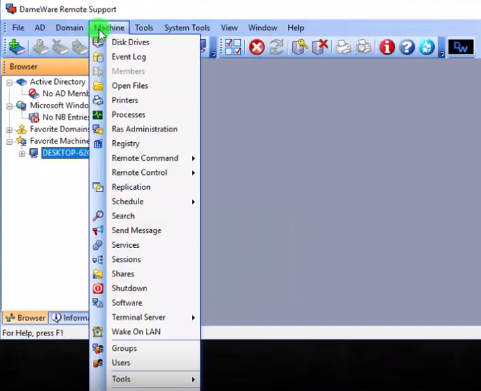
First, there is the selection of Microsoft administrative tools that will allow you to perform basic troubleshooting skills without having to launch a full remote session. Through these tools, you can start/stop/restart services running on remote computers and also view and clear event logs. Additionally, they can be used for monitoring System performance, executing Wake On Lan tasks, and Editing Registries just to name a few.
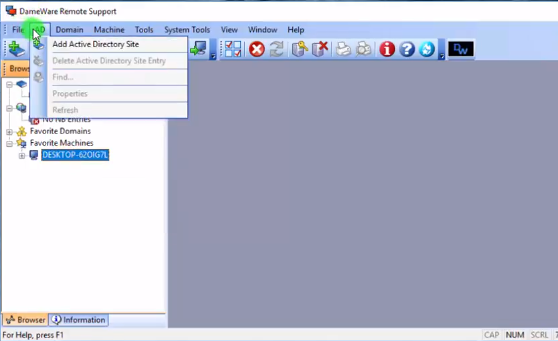
The tools also extend their functionality to the AD and allow easy management of local users, shares, and other peripherals. Some of the tasks you can carry out in the AD include unlocking user accounts, resetting passwords, editing group policies and also creating new/updating existing AD objects.
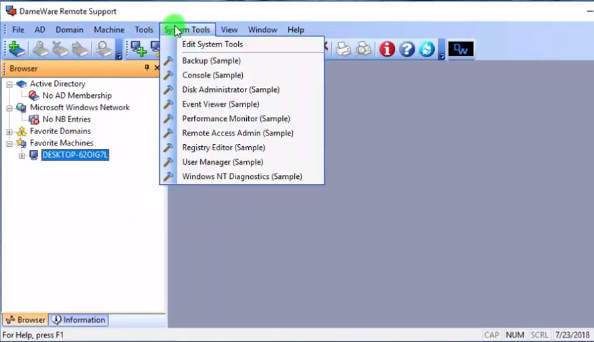
Here you will also find the Dameware Remote Support export tool which allows you to move information such as the windows configuration files from the remote computers and export them to CSV or XML external files. Some of the other administrative tools in the DRS include a Disk administrator, Performance Monitor, and a Server Manager. The various tools in DRS are available in a tree view and each one will be opened in a different tab when selected to simplify the process of switching between them.
Dameware Remote Support Security
There is no shortage of ways in which a hacker can exploit the remote access technology to gain access into your network and exfiltrate important company data. Which is why SolarWinds employs a number of security measures not only to authenticate anybody trying to send a remote connection but also to ensure that the data being sent between connections cannot be hijacked.
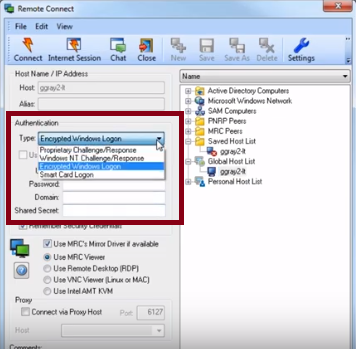
The Dameware Remote Support includes 4 authentication methods to choose from. The first is the proprietary challenge in which the username and password used to login to the remote session are configured on the Dameware client agent that’s installed on the host computer. Then there is the Windows NT challenge which utilizes the integrated security of the Windows Operating System. The third is the Encrypted Windows logon which is similar to the Windows NT challenge but now the username and password are sent to the remote computer in an encrypted manner. Finally, we have Smart Card Logon. Dameware Remote Support was the first remote desktop to allow authentication using this method.
Some additional security measures employed by Dameware includes the ability to define specific IPs that can initiate a connection, add another password or shared secret, or only allow connections from people with administrative permissions.
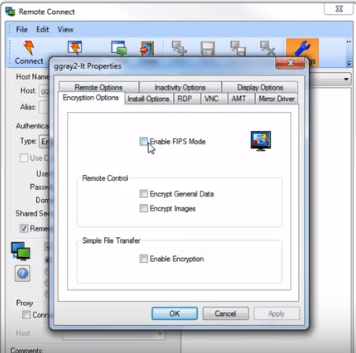
To protect active sessions from being intercepted Dameware uses multiple encryption algorithms that are implemented by the Microsoft built-in Cryptographic Service Providers and CryptoAPIs. And to tune things a little higher, it also uses RSA’s BSAFE Crypro-C ME encryption modules when it’s running in FIPS mode.
Integration with the SolarWinds Web Help Desk
Remote Desktop Softwares are tools that help in the easy deployment of customer support. Therefore, you can see why integration with a Help Desk software can aid in value addition. You will now have a central platform where your end users can raise all their tickets and requests and then you will be at a better position to assist them by remotely accessing their computers. The Web Help Desk seamless integration with the Dameware Remote Support eliminates the need to switch between the two applications and allows you to launch into the troubleshooting and problem resolution process directly from the Help Desk interfaces.
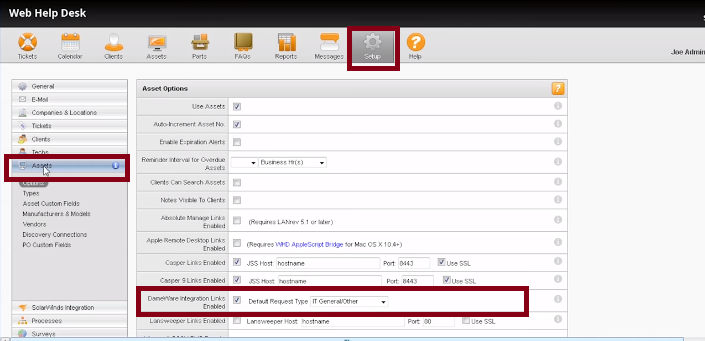
The Downsides of Using Dameware Remote Support
Dameware is such a complete tool that it’s hard to find any fault within it. The issues I am going to address are not deal breakers but they would improve the overall experience when using the remote desktop software.
So, one of the disadvantages of using Dameware is the inability to remotely control mobile devices. It’s nice that the system admin can use their mobile phone to access workstations and servers. But, with the increased acceptance of mobile phones into business networks, it would be great if they could also be controlled remotely.
Then there is the fact that you have to open ports on the remote computer before it can accept remote internet sessions. This won’t be much of a problem to system administrators who are the actual targets of the software but for a beginner user who is not familiar with port forwarding, then it will steepen the learning curve.
Also, I think that the fact that TeamViewer offers remote support to mobile devices and does not require any special port configurations for most of its connections should be a source of concern. Dameware and TeamViewer are not what I would call direct competitors but that has not stopped people from comparing them. You can check our post on Dameware vs TeamViewer to get more insights.
Dameware Remote Support Pricing
I think the Dameware Remote Support pricing plan is quite clever and convenient. SolarWinds charge you based on the number of Technicians using the software but does not impose a limit to the number of remote computers the technician can connect to. This, therefore, allows you to use fewer administrators to support several end-users and consequently save on administration costs.
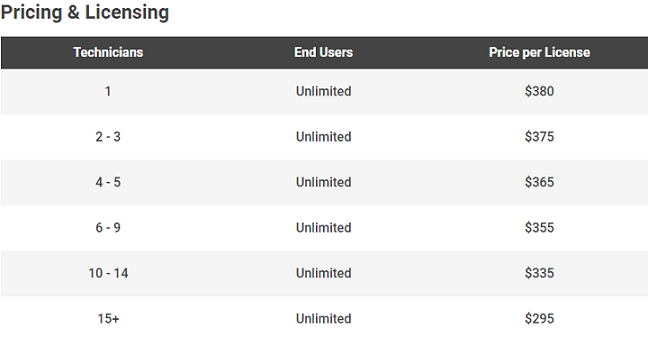
The current price for one licensed user is $380 that will need to be renewed annually if you want continued access to SolarWinds support and product updates.
System Requirements
The system requirement for the Standalone and Centralized installations differ but overall they are very minimal requirements.
Note that Dameware Remote Support only works on Windows systems. That is Windows vista up to Windows 10 for workstations and for Windows server it is compatible with Windows server 2008, 2012, and 2016 including the R2 editions.
For the Centralized Server system, you need a minimum of 1GB free hard drive space, a Quad-core CPU with a processing power of 2.0GHz and 4GB RAM. But if you are using the Standalone software you can make do with 150MB free hard disk space and a 1GHz CPU that has a 4GB RAM.
Conclusion
At this point, there is not much left to say. The SolarWinds Dameware Remote Support has all it takes to offer prompt and efficient remote services to the end-user. The tool has curved a niche for itself in the provision of IT services which is what makes it perfect for system administrators and also the reason it cannot be compared to most of the other remote desktop software.
The centralized server system makes DRS perfect for deployment in big enterprises and the Standalone mode then ensures it’s still feasible for small businesses. Not only that, I think this remote desktop software will be perfect for Managed Service Providers (MSPs). The extra management tools and the ability to integrate with the Help Desk means you will now have a complete support management system and if that does not cement the SolarWinds DRS as an industry leader, I don’t know what will.

